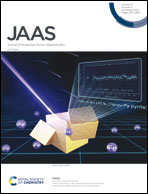Direct determination of lanthanides by LIBS in REE-rich ores: comparison between univariate and DoE based multivariate calibrations with respect to spectral resolution
Abstract
Laser-induced breakdown spectroscopy (LIBS) was used to detect rare-earth elements (REEs) – Ce, La, Nd, Pr, and Sm – in ores. The problems of significant overlapping of REE lines in LIBS emission spectra and high pairwise correlation between REE contents in certified reference materials (CRMs) of natural origin, decreasing the multivariate model prediction capacity, are addressed in the study. The latter is done by employing a specially designed calibration set (mixtures of REE oxides and Fe2O3 + TiO2 as the matrix), based on Latin hypercube sampling providing an extremely low correlation (<0.03) between the contents of different REEs, for the first time for LIBS measurements. Its applicability was assessed for univariate and multivariate (partial least squares regression) calibration models to solve the above problems. The content of each REE in the calibration set varies by two orders of magnitude and completely covers the concentration range in the independent test set of CRMs of natural REE-rich niobium and uranium ores. The selection of analytical lines was carried out through the thermodynamic modeling of LIBS spectra and helped to find the most intensive but not self-absorbed lines in very rich emission spectra of ores. This step greatly reduced the number of required experiments. The comparison of the analytical performance of high- (0.03 nm) and low- (0.26 nm) resolution spectrometers coupled to a high-energy laboratory laser and a high- (0.06 nm) resolution spectrometer coupled to a low-energy portable laser is presented. For the highest resolution spectra, PLS-R models enable the quantitative determination of Ce (0.046–3.95%), La (0.026–2.41%), and Nd (0.015–1.18%) and semi-quantitative determination of Sm (24–1500 ppm). The lowest resolution spectra and PLS-R allow the semi-quantitative determination of La. For the system with a portable laser, PLS-R models enable the determination of Ce (quantitative) and La (semi-quantitative). Pr and Nd were special cases due to considerable matrix effects for atomic lines, addressed by the use of an ionic line of Nd for the highest resolution spectrometer. Reliable Pr ionic lines were not detected due to the strong interference of matrix elements (Fe and Ti). The results show that LIBS has potential to quantify REEs in natural ores.

- This article is part of the themed collection: JAAS HOT Articles 2022


 Please wait while we load your content...
Please wait while we load your content...